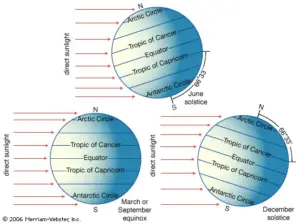
This year, the autumnal equinox occurred on Saturday, Sept. 23, at 1:50 a.m. Central Time. During the equinox, the sun shines directly on the equator as its position moves from one hemisphere to the other. The word “equinox” is derived from the Latin word “aequus,” which means “equal,” and “nox,” which is the Latin word for “night.” During the 24 hours of the equinox, there are about 12 hours of day and 12 hours of night.
You may hear that daylight and nighttime are of equal length on the equinox. But during the equinox at our midlatitude location, there are approximately eight more minutes of daylight for two reasons: the sun’s shape and atmospheric refraction.
Sunrise time is most frequently defined as when the leading edge of the sun first touches the eastern horizon. Sunset occurs when the sun’s trailing edge touches the western horizon. This provides an extra 2½ to 3 minutes of daylight at our latitude.
In addition, our atmosphere acts like a lens, bending the light from the sun. When the sun is near the horizon, this refraction of the sunbeams has the effect of making the sun appear about a half a degree from its true position. When the sun appears to be on the horizon, it is actually just below the horizon geometrically. Atmospheric refraction advances the time of sunrise and delays the sunset, adding approximately six minutes of daylight. So, we have more daylight than night at the equinox.
The fall equinox marks the midpoint between the summer and winter solstices, and our daylight hours will continue to decrease as we approach the shortest day of the year, with about nine hours of daylight on Dec. 21. Our temperatures will also be getting colder.
Steve Ackerman and Jonathan Martin, professors in the UW-Madison department of atmospheric and oceanic sciences, are guests on WHA radio (970 AM) at 11:45 a.m. the last Monday of each month. Send them your questions at stevea@ssec.wisc.edu or jemarti1@wisc.edu.

